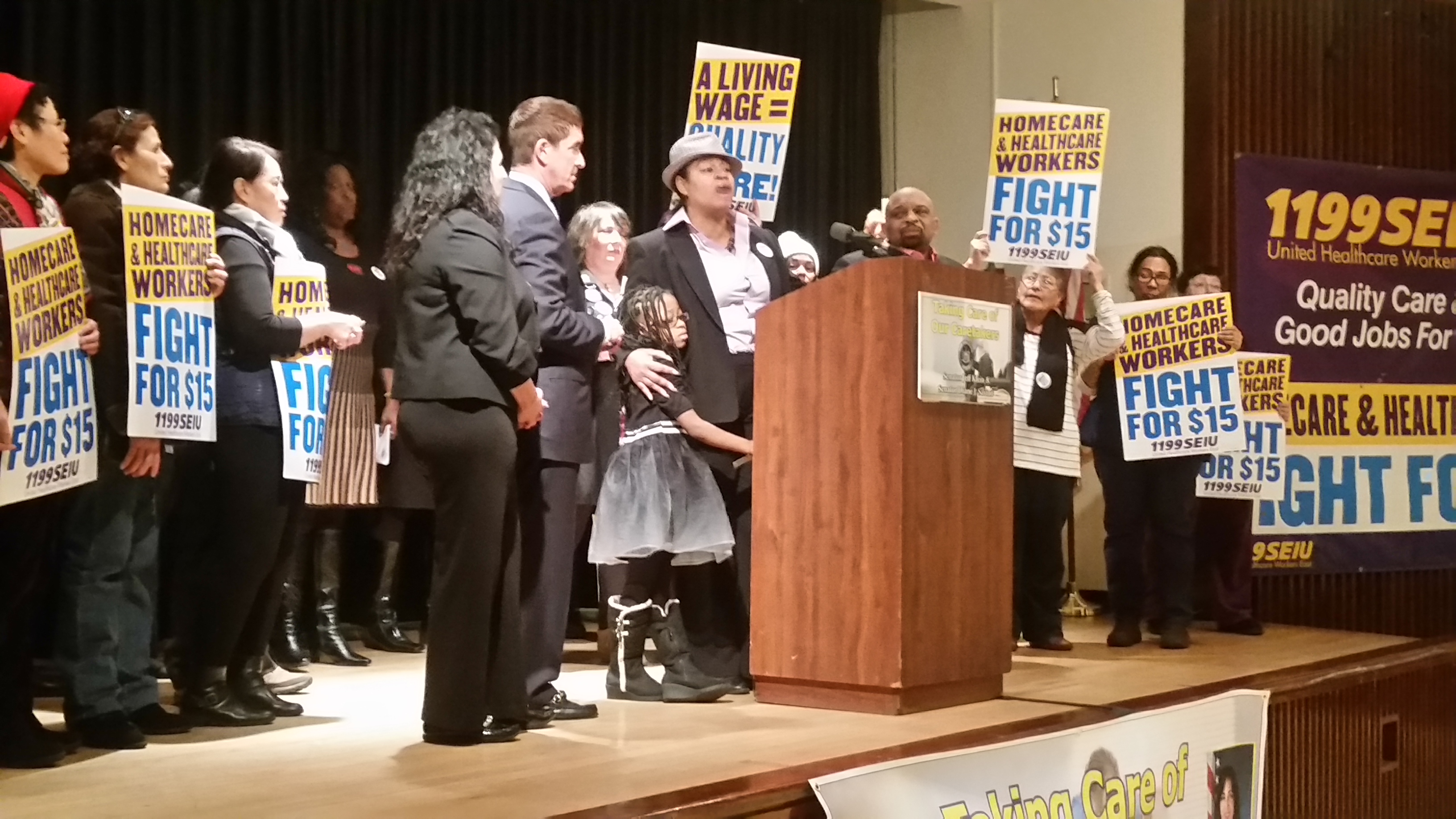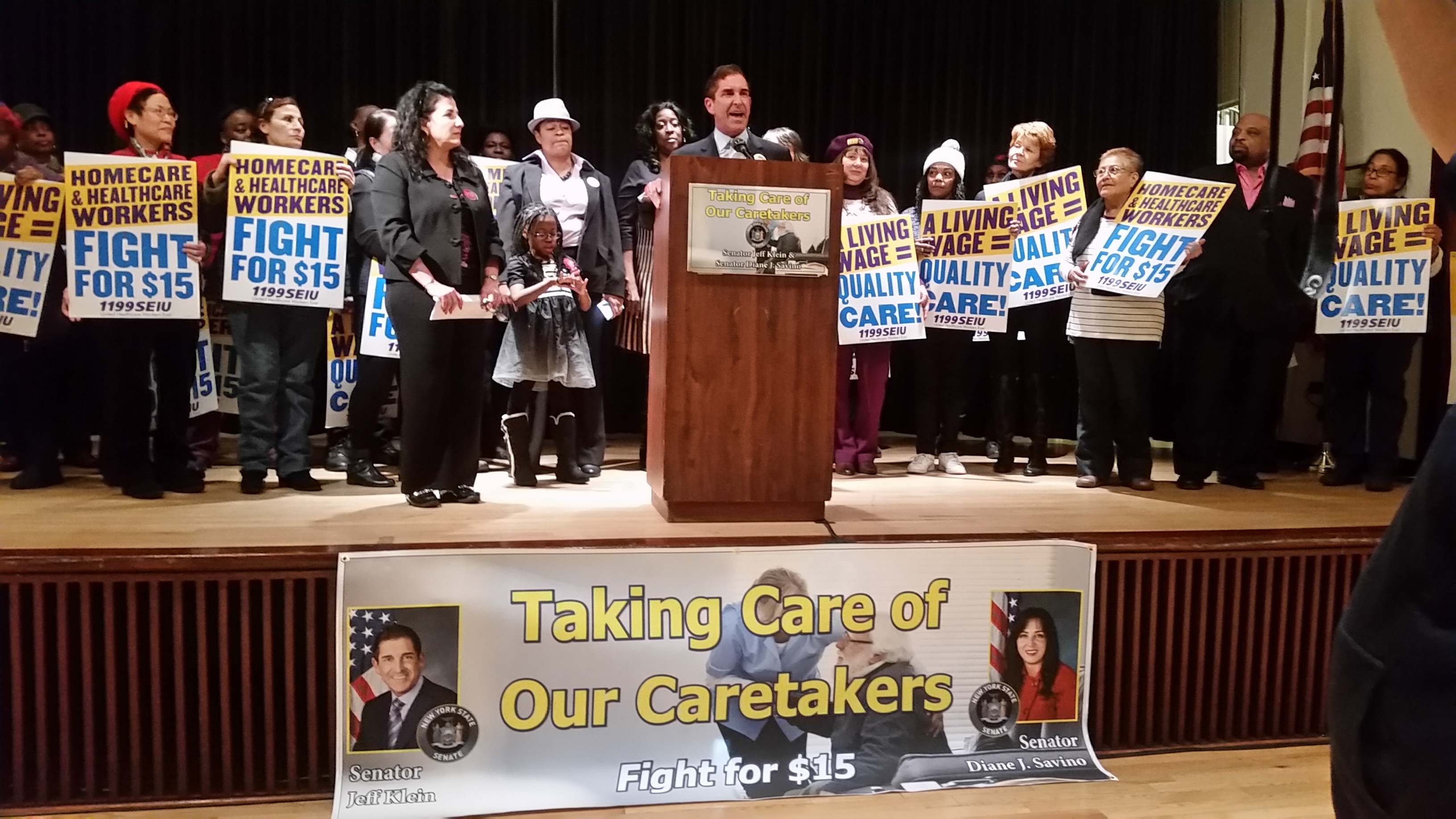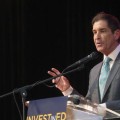“Taking Care of Caretakers” lays out wage increases resulting in $330 million in public assistance savings for the state, economic growth and less worker turnover
NEW YORK, NY – Independent Democratic Conference Leader Jeff Klein (D-Westchester/Bronx) and State Senator Diane Savino (D-Brooklyn/Staten Island) joined George Gresham, president of 1199 SEIU, at a rally for a $15 minimum wage on Thursday, and released, “Taking Care of our Caretakers,” a report laying out the IDC’s proposal to raise the wage for home health aides, direct care workers and personal care aides.

Lisa Johnson, homecare worker and 1199 member, holds her daughter as she speaks about having to work multiple jobs to make ends meet.
The report highlights how raising the minimum wage for caretakers would result in $330 million in public assistance savings to the state and $535 million in economic growth. Workers would see an average of $5,000 in additional pay per year, as well as an addition of up to 4,200 new jobs across the state.
“Home and healthcare workers are the people we turn to when we need to care for our mothers, fathers and grandparents. However, while these workers are ensuring that our loved ones’ health needs are met, their own financial health is ailing. As “Taking Care of Our Caretakers” shows, raising home and healthcare worker wages to $15 per hour will do more than just raise the wage — it will raise up New York’s economy, save the state and local municipalities $330 million in public assistance funding, and halt the high turnover of workers in this critically important field. This is our opportunity to lift these workers out of poverty-level wages by putting an additional $5,000 in workers’ pockets, and to provide a better quality-of-life for those that we trust to care for our most vulnerable. Let’s care for our caretakers and fight for $15,” said Senator Klein.
“It is unconscionable to think that those who we entrust with the care of our loved ones must struggle to make ends meet for themselves and their own loved ones. While cost of living continues to rise, $11 an hour is not going to pay the bills. No person should have to juggle extra jobs while working full-time in the healthcare industry. That is why Senator Klein and I are committed to fighting for this raise in Albany, so that home and health care workers receive the pay they need to be able to stay in their jobs and support their families,” said Senator Savino.

Senator Klein speaks at 1199 rally with Senator Savino and 1199 President Gersham.
“Homecare, direct care and all New York healthcare workers thank Senators Klein and Savino and the Independent Democratic Conference for their support. Homecare workers perform all the vital duties that allow patients to live in their own homes – they lift them out of bed, make sure they take their medicine, bathe and dress them. Yet most homecare workers only make around $10 an hour and are forced to rely on public assistance. It is a moral travesty that 30% of New York homecare workers are on food stamps. That’s why we’re fighting for the $15 minimum wage so homecare, healthcare and all working New Yorkers have dignity, security and a better future for their children,” said 1199SEIU President George Gresham.
“Taking Care of Our Caretakers,” details the 274,548 home and healthcare workers who would see an increase in gross wages by a total of $2.287 billion, with a net gain in wages of $1.372 billion dollars. For home health aides, the average net gain would be $5,304, while personal care aides would gain an average of $4,649.
These raised wages would be reflected in overall economic growth, as workers would most likely spend their new wages on needs or expenses they had been previously unable to afford. The result would be increased consumer spending and a rise in the Gross Domestic Product (GDP) of an estimated $312 million to $535 million, annually.
Higher wages for these workers would also result in higher income tax revenues for the state — to the tune of $97 million to $101.7 million. The higher hourly wage would additionally lower the number of individuals eligible for a number of public assistance programs, including Temporary Assistance for Needy Families (TANF), Medicaid, and the Earned Income Tax Credit, ultimately saving the state approximately $330 million.
Additionally, higher wages would result in lower worker turnover rates. In an industry known for its high worker turnover, keeping workers in their current roles for longer means more consistent care for patients, and better overall care for those most vulnerable.
“I’ve worked in homecare for 13 years. This job may not be for everyone, but it’s for me. That’s why I feel we should be making more than we are now. Right now I make $11.10. That’s while the price of almost everything has gone up. We have to work a lot of hours just to see anything. I have a daughter. She’s 19 and in college. I took out a loan for her because I don’t want her to have the burden hanging over her. I’m making payments, but there are times I don’t have food in my house. If I have to send her money, it’s hard. I tried to get on SNAP or some form of public assistance. They told me I make too much money. I support the Fight for $15. Right now I just live paycheck to paycheck,” said Shelia Gibson, homecare worker with the Puerto Rican Family Institute (OPWDD).
“I grew up very poor but it made me into the person I am. I learned to pay it forward. I can imagine needing a homecare worker or being homeless myself so I have to do what I can for others. I love to provide care and support for my clients and their families. Homecare workers are family for our clients, we devote ourselves to giving them dignity, and we deserve $15 an hour. We just want a fair shot so we don’t have to work three or four jobs so we can spend time with our children,” said Lisa Johnson, homecare worker with Bestcare.
“I was an actress by profession. Everything changed after I fell down a flight of stairs. After painful surgery, I found I had to reinvent myself. During my rehabilitation, I had the opportunity to talk to and learn from elderly patients. It was those encounters that fueled my desire to work in homecare. I work primarily with elderly patients, many with dementia. We’re there with patients when their families aren’t. I’m fully behind the Fight for $15. I’m working two jobs, yet I’m still behind on my rent, to mention other pressing bills like utilities and phone costs. Without my phone, I couldn’t work. I have a daughter living in Florida who’s trying to attend nursing school. It pains me I can’t help her more,” said Mary Ellen Gibbs, homecare worker with Elderserve.

















Follow Us